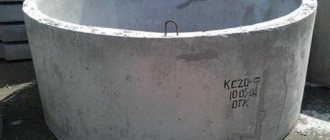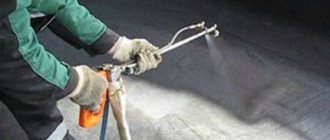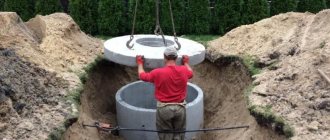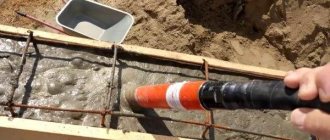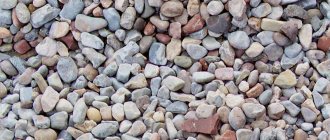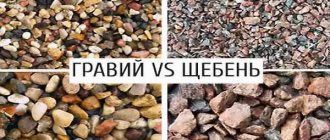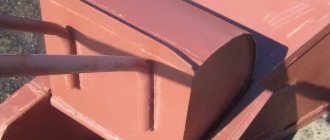In the absence of a centralized water supply, an alternative option is to create a well using reinforced concrete rings. These reinforced concrete products can also be used for constructing a sewer tank (septic tank). The products are made from concrete, which is reinforced with steel reinforcing wire of class BP-1 or hot-rolled rods of classes A-I, A-II, A-III. Factory-made blocks have a round hollow cross-section, an internal diameter of 0.7-2.0 m and a height of up to 0.9 m. Before making a well from reinforced concrete rings, it is necessary to calculate the volume of one product and determine them required quantity.
Selection of rings for wells
Wells used in various systems must strictly comply with their assigned functions. For this purpose, manufacturers produce a large assortment for selecting rings according to the main linear dimensions. The versatility of the elements allows you to assemble a tank, the volume and depth of which varies over a wide range.
When ordering, be sure to ensure that the internal diameter of the elements is strictly the same, otherwise the tightness will be broken and leaks will appear. For the convenience of selecting structural elements of wells, they are subject to markings, which contain the main dimensions of the rings. The first number indicates the diameter of the product, and the second the height of the flange. The wall thickness in elements with a diameter of up to 1200 mm is 80 mm. The dimensions of the rings and their weight are directly related.
Pricing policy for well rings
It is important for the consumer to know approximately how much it will cost to purchase products such as concrete rings for a well. Sizes and prices always increase proportionally. Before purchasing, you should consider the offers of several sellers. According to reviews, the price may vary significantly from different sellers. The average cost of the most popular ring size, KS 10-9, is about 1,800 rubles. The thickness of its walls is 8 cm, and its weight reaches 640 kg. However, there are many other sizes of similar products on sale.
For rings with an internal diameter of 70 cm, the lowest price is set. Depending on their length, the cost can range from 350 to 1500 rubles. The most expensive rings today are those with a diameter of 200 cm and a height of 90 cm. Their price is around 4,800 rubles. The weight of such a product is 2300 kg. If the home owners have never installed a concrete ring before, it is better to entrust the choice to a professional. He, guided by his experience, will be able to choose the right variety.
Cesspool made of concrete rings without a bottom: do-it-yourself installation
Before you start laying the rings, you need to prepare a pit 3 meters deep for the cesspool. Its width should be slightly larger than the diameter of the reinforced concrete rings selected for the septic tank.
You can dig a hole for a foundation pit yourself using shovels, or you can hire special equipment to get the job done faster.
The bottom of the pit must be leveled with sand, on top of which a concrete ring with a bottom or an ordinary wall ring is installed.
How to install a septic tank from reinforced concrete rings:
- Install the first ring. Check that it does not lean to the side.
- Having installed the next wall ring, fill the space between the septic tank and the pit.
- Gradually build a septic tank, not forgetting to check the level of installed reinforced concrete rings.
- Seal the joints between the rings with a solution of cement and sand.
- Using a hammer drill or grinder, make holes for the sewer pipes. The drain pipe from the house is installed at a slight angle.
- If the sewerage system consists of several septic tanks, in addition to the drainage pipe, you need to lay a pipe connecting the septic tanks. This pipe is located 20-30 cm below the waste pipe.
- To prevent runoff from getting into the ground, it is important to choose the right waterproofing. For this, bitumen or polymer mastic is used.
- The final stage is installing covers on the septic tank. After the joints have dried, you can begin using the cesspool.
A septic tank made of reinforced concrete rings does not require special operating rules, but it is important to clean it on time and use special bacteria to better process wastewater.
Additional well elements
Concrete rings form the basis of wells, but without additional elements it is difficult to use the structure. They can come complete with products, or they can be offered separately. The ring, equipped with a bottom, is the basis of the structure and serves as a foundation. A ring with a lock ensures increased moisture resistance and tightness of the structure. The ends of the rings are equipped with folds (special grooves) that ensure tight contact. The weight of different types of rings ranges from 200 kg to 1 ton.
For safety reasons, wells are equipped with covers with a manhole for maintenance. An element such as the bottom is a supporting structure and is used in laying tunnels and arranging dead-end areas. Its diameter corresponds to the internal or external diameter of the mounted product. Don't confuse it with the bottom.
To evenly distribute the load on the well structure, floor slabs are used, installed every meter of the structure. To bring the structure cover to the required level, support rings are used. They can be buried level with the ground or made into a ledge.
Ways to increase water volume
Regardless of the types, wells are divided into two types:
- imperfect or incomplete, when their bottom does not reach the waterproof layer, due to which the influx of water into the structure can be carried out both through the side walls and through the bottom;
- perfect or complete - these are structures whose bottom rests on a water-resistant layer, and therefore the supply of life-giving moisture occurs exclusively through the side walls.
You can increase the volume of water in an imperfect well by deepening it to water-resistant rock. If it is perfect, then an additional reservoir or sump is installed in the water-resistant rock, which helps to increase liquid reserves. In some cases, the underwater part of the structure is expanded in the form of a tent, which contributes to a significant increase in the volume of life-giving moisture.
Well deepening diagram
To summarize, we can say that on average, about 0.5 cubic meters of liquid enters the well within an hour, and this is slightly less than the amount contained in one ring. This means that for personal use, the key type of structure would be an ideal option, since its construction will not require significant financial investments due to the absence of the need to dig deep to a significant distance from the surface of the earth and purchase a large number of rings.
Standard requirements
GOST 8020-90 regulates the production of all structures made of heavy (that is, not porous in any way) concrete with and without reinforcement, used for the construction of round wells for the following purposes:
- Sewer (inspection, cleaning, collector, etc.)
- Gas pipelines (of course, where the gas pipeline runs underground).
- Plumbing. This includes wells for draining cold water to a private house, intended for installing shut-off valves on the highway, wells for fire hydrants and many others.
- Storm sewer wells.
It is curious: the standard does not provide for the use of structures for centralized heating inlets, construction of water intake wells, septic tanks and cesspools. However, in practice, such universal products, of course, are used much more widely than provided for in the regulatory document.
Let's go over the most interesting points of the standard.
- The product labeling indicates its purpose and main dimensions. Thus, KS-25-12 is a wall ring (intended for the working chamber or well neck) with a diameter of 2.5 meters and a height of 1.19 meters (the marking rounds the actual values to the nearest round number).
- Reinforcement, if present, must be completely hidden by concrete to avoid accelerated corrosion. At the same time, the types of fittings are strictly regulated.
- If the design of the ring provides for the presence of running brackets, their width is taken to be 30 cm, depth - at least 12 cm. The brackets are protected from corrosion by a paint coating.
- Rings can be stored in no more than two rows vertically. Bottoms and floor slabs - no more than six rows, with the obligatory laying of gaskets with a thickness exceeding the height of the mounting loops.
How much does a well ring weigh?
Wells, underground tunnels, and industrial stormwater drainage systems are the main objects where concrete rings are used. They are widely used in the construction of wells for servicing water supply, sewer and gas transmission networks.
The concrete ring, as a structural element, is produced in certain sizes. The change in diameter occurs in the range of 0.7–2 meters, the standard shape in height is about 500 mm, while it is possible to manufacture a ring with a wall height of up to 1.8 meters. All produced concrete rings for the installation of wells are necessarily marked in accordance with the requirements of GOST standards.
Reinforced concrete structures are considered monolithic precisely due to their heavy weight. High-quality installation holds the individual elements together and makes them very resistant to external influences. By using reinforced concrete products during construction, you will undoubtedly increase the operational characteristics of the facility.
For example, when constructing sewer networks, large concrete rings of 1 meter or more are used. For water mains, rings weighing approximately 640 kg are used. Having such a weight, transportation and installation of structures require the use of special equipment. The weight of the concrete ring cannot be reduced, otherwise the ring will contain cavities.
The principle of the design and operation of this design
For lining the walls of a regular cesspool without a bottom, ready-made concrete rings are perfect. You just need to lower them to the bottom, and then seal the seams and carry out waterproofing work. This is easier than concreting the walls of a cesspool or laying bricks. Such sewerage devices are ideal for a summer house, which is used only in the summer, on weekends and on holidays. If the volume of wastewater exceeds a cubic meter per day, it is worth considering the construction of a two-chamber device.
In this case, the volume of work will at least double, since you will actually have to dig two holes, concrete the bottom of one of them, arrange drainage in the other, etc.
As a result, the efficiency of wastewater processing will increase several times. First, human waste will fall into the first pit, the bottom of which is carefully concreted. In this compartment, solid particles will settle to the bottom, slowly being processed through the fermentation process and turning into sludge. This part of the cesspool made of concrete rings must be cleaned periodically.
Tip: To improve the processing of solid waste, cultures of special anaerobic bacteria are added to the settling tank. It must be remembered that such organisms cannot tolerate the presence of chlorine-containing components in water.
The sump is connected by an inclined pipe to the second compartment of the cesspool, which is a drainage well. The bottom of this pit is not concreted, but covered with a layer of drainage. Wastewater, partially purified in the first compartment, undergoes natural post-treatment and enters the ground. Such a cesspool requires the services of sewage trucks much less often than a regular one, and the likelihood of soil contamination with wastewater is significantly reduced.
Carrying out installation work
Before starting construction work, you should draw up a detailed plan and select a suitable location. In addition to the desire to preserve the aesthetic appearance of the landscape, it should be taken into account that the cesspool should be located:
- no less than five meters from a residential building;
- no less than 30 meters from a source of drinking water;
- in a place accessible for the entry of special transport of sewer trucks.
Please note: When choosing a suitable location for a cesspool, you should take into account not only the location of your own house, well or well, you must ensure that the sewerage system is located at a sufficient distance from neighboring buildings and structures.
To make a two-chamber cesspool from concrete rings, you must:
- Dig two pits in a suitable place (sometimes one spacious pit is enough).
- Concrete the bottom of the pit in which the sump will be built. After drying, cracks almost inevitably form in the concrete, which must be repaired to ensure sufficient tightness. This stage will take about a week or a little more.
Tip: To avoid concreting the bottom of the pit, you should buy a concrete ring, the bottom of which is already constructed.
- Install concrete rings in the hole.
Carry out thorough sealing of seams and waterproofing of the structure, for example, using cement mortar and liquid glass, bitumen, etc.
Concrete rings should be lowered into the pit carefully so as not to damage the structure
What requirements does GOST 8020-90 contain for well rings? What types and sizes are these products? How much do they cost?
We will answer these and many other questions in the article.
